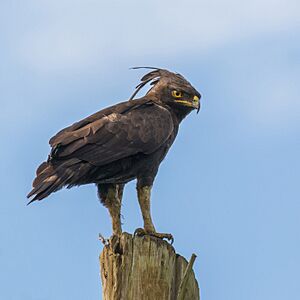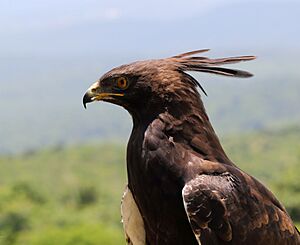Long-crested eagle facts for kids
Quick facts for kids Long-crested eagle |
|
|---|---|
 |
|
| In Queen Elizabeth NP, Uganda | |
| Conservation status | |
| Scientific classification | |
| Synonyms | |
|
The long-crested eagle (Lophaetus occipitalis) is a cool African bird of prey. You can easily spot it because of the long, shaggy feathers on its head, which look like a crest! This eagle belongs to the Accipitridae family, which includes all eagles. It's the only species in its group, called Lophaetus. You can find these eagles across central and southern Africa. They usually live near the edges of forests and wet areas. They lay 1 or 2 eggs, and they mostly eat small mammals.
Contents
What the Long-crested Eagle Looks Like
The long-crested eagle is easy to recognize when it's sitting down. It has a long, shaggy crest of feathers and is mostly dark brown or black. In Uganda, people sometimes call it Kamusungu-sungu. Adult eagles are blackish-brown. Their long, thin feathers on the back of their head stand up to form the crest.
When they fly, you can see white patches on their wings. These patches are made by their main flight feathers. Their tail is black with light grey stripes. Adult eagles have bright yellow eyes, but females might have darker eyes. Their beak area (called the cere) and feet are yellow, but males have lighter, almost white feet.
Young eagles look similar to adults. However, their feathers are lighter in color, and their crest is not fully grown. Their eyes are grey. These eagles are about 53 to 58 centimeters (21 to 23 inches) long. Females are heavier, weighing about 1300 to 1500 grams (2.8 to 3.3 pounds). Males are smaller, weighing 912 to 1300 grams (2 to 2.8 pounds).
Where Long-crested Eagles Live
The long-crested eagle lives in many parts of Africa south of the Sahara Desert. You can find them from Senegal and Gambia in the west, all the way to Ethiopia in the east. They also live south into the Eastern Cape of South Africa, northern Namibia, and northern Botswana.
These eagles usually stay in one place. But in very dry areas, they might move around to find food and water, especially after it rains.
Long-crested Eagle Habitats
The long-crested eagle likes to live on the edges of forests and in wet woodlands. They especially like areas near grasslands, marshes, rivers, or streams. You might also find them in drier woodlands, mixed farmlands, or even near sugar-cane fields and fruit orchards. They can also live in areas with planted trees like pine or eucalyptus.
These eagles can live from sea level up to about 3,000 meters (9,800 feet) high. However, it's rare to find them above 2,000 meters (6,600 feet).
Long-crested Eagle Behavior and Life Cycle
Reproduction and Nesting
Long-crested eagles are very protective of their territory. During courtship, the male eagle performs amazing dives and flies in a rocking motion to impress the female. They often call loudly during these displays.
Both the male and female build the nest. They make a platform out of sticks and create a bowl-shaped dip in the middle. They line this dip with fresh green leaves. The nest is usually built in the middle part of a tree, close to the trunk, near the edge of a forest. Sometimes, long-crested eagles will even use an old nest built by another bird, like a black sparrowhawk.
They can breed all year round, but most eggs are laid between July and November. The female lays 1 or 2 eggs. She does most of the work of keeping the eggs warm, which takes about 42 days. While she is on the nest, the male brings her food. The eggs hatch at different times, sometimes up to two weeks apart. This means the first chick to hatch is usually bigger than the second.
When the young eagles hatch, the male eagle mostly feeds them at first. It takes about 53 days for the young birds to grow enough to leave the nest. After they fledge (fly for the first time), they still depend on their parents for about 2 to 3 more months. Sometimes, their nests can be attacked by animals like monkeys or genets.
Long-crested eagles can breed any time of year if there is enough food. Females might leave their territory when it's not breeding season. Also, their home areas are smaller during breeding season and get bigger when they are not breeding. Females hunt closer to their chicks when they are young. As the chicks grow, the female travels farther to find food. Other birds like black sparrowhawks and Egyptian geese sometimes compete for nesting spots. Other raptors, such as black kites and Wahlberg's eagle, also compete for nesting space.
What Long-crested Eagles Eat
Rodents make up almost all of the long-crested eagle's diet, sometimes as much as 98%! In southern Africa, they eat rodents like the greater cane rat, vlei rats, African marsh rat, and four-striped grass mouse. They also eat other animals like birds (including owls and young raptors), frogs, lizards, and even insects. Sometimes, they might even eat fish or fruit.
The long-crested eagle is a "sit and wait" hunter. It sits on a high perch, looking down at the ground. When it spots prey, it swoops down with a smooth, gliding flight to catch its meal.
Conservation Status
The number of long-crested eagles is estimated to be in the tens of thousands, and their population is expected to grow. This is partly because new areas are becoming suitable for rodents, which are the eagle's main food source. This happens due to changes in habitats.
Even though the long-crested eagle is listed as "least concern" by the IUCN Red List (meaning it's not currently endangered), it still faces some dangers. These include changes to their habitats, poisoning, and accidents with power lines or cars.
A newer problem for these eagles is an increase in doves, often because people feed them. These doves can carry a disease called trichomoniasis (also known as canker). This disease spreads quickly among doves. When eagles eat infected doves, they can get the disease. Trichomoniasis can cause serious damage to the eagle's throat and mouth, making it unable to eat.
Images for kids







